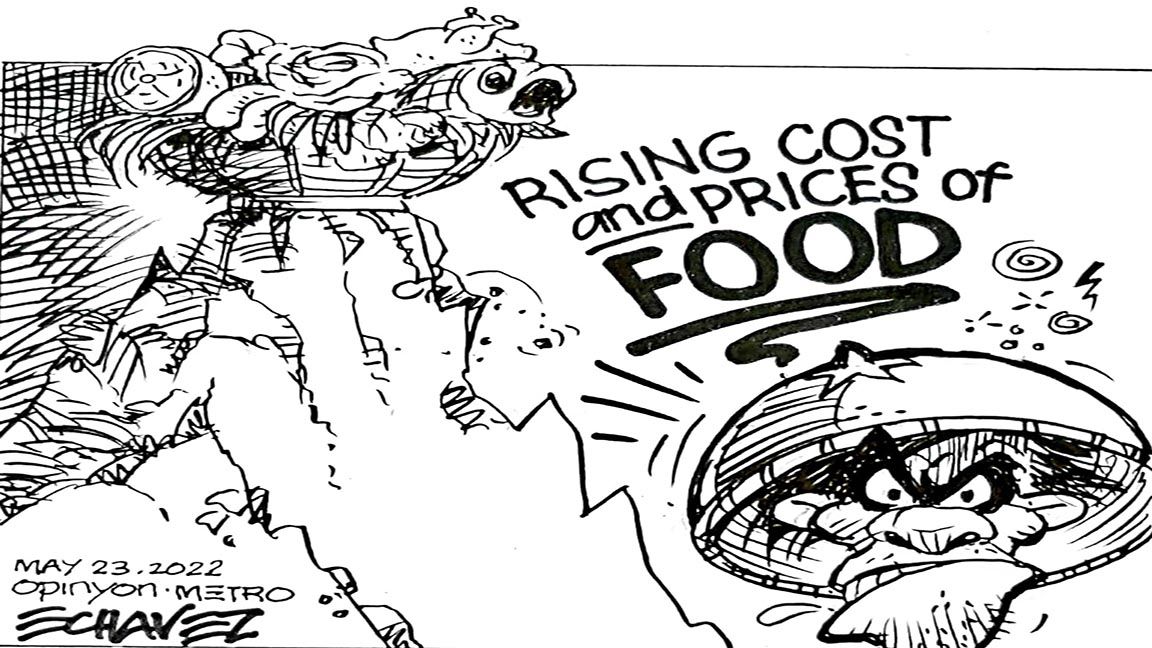A hungry man is an angry man. Ang ibig sabihin nito, ayon sa Oxford Reference ay “someone deprived of a basic need will not be easily placated.” Ito ay isang proverbial saying noong mid-17th century during a great famine.
Truly, food insecurity—marked by an uneven distribution of food supply and its concentration in food-producing centers, while being inadequate in urban areas—is deeply felt in Philippine society. May mga pictures na nagpapakita na sa panahon ng tag-init, tinatapon o binabaon muli sa lupa ang mga gulay na hindi madala sa National Capital Region samantalang ang NCR ay hirap na hirap makakuha ng supplies at sobrang taas ng mga gulay, hanggang ngayon na patungo na tayo sa tag-ulan.
Ang presyo ng bigas ay halos di na maabot ng pangkaraniwang tao—akalain mo bang umabot na ito sa lagpas P40 isang kilo, samantalang nung panahon ni Marcos Sr., ng nagko cover pa kami ng Department of Agriculture ay pinagpupustahan pa naming na kapag ang bigas ay lumagpas sa P10 a kilo, magkaka revolution. Heto nasa P40 plus na tayo e wala namang umaaklas kundi ang presyo lamang.
Sa column ni dating Finance Secretary Gary Teves sa Star, sinabi niya na food security, which pertains to the availability, accessibility and affordability of food, has long been among the top concerns of most Filipinos. Tama.
Even during periods of abundant harvests, farm produce is hardly accessible or difficult to bring to the market because of inadequate farm-to-market roads, transport, and storage facilities. Mobility restrictions brought about by the pandemic also complicated the delivery of produce to some areas.
In 2020, 62.1 percent of the population or about six out of 10 Filipinos were at risk or were actually suffering from inadequate access to food.
The bigger problem for many, however, is the rising cost and prices of food, which drive up the country’s inflation rate. Food and nonalcoholic beverages account for 39 percent of Filipino consumers’ expenditures. Higher food prices will continue to eat up a bigger share of their incomes.
Ayon sa Philippine Statistics Authority, 26.1 million or 23.7 percent ng population live in poverty with per capita income below the P2,416 per month threshold. Itong halaga ay hindi man sapat to cover food and basic non-food needs tulad ng clothing, housing, transportation, education at healthcare.
May 10.9 million Filipino who earn P1,679 a month at hindi maka afford ng basic food like meat, milk, fruits and vegetables. Samantalang many of food producers (farmers) are themselves too poor. Latest available records showed that in 2018, 31.6 percent of Filipino farmers, 26.2 percent of fishermen, and 24.5 percent of people in the rural areas were living in poverty.
The rising cost of food and extreme poverty are to blame for the high rates of hunger and malnutrition, with over 33 percent of Filipino children suffering from malnutrition. This has long-term adverse impact on the children’s physical and mental development, productivity and economic potential, which in turn is a real threat to the country’s economic stability, ika ni Teves.
Modernizing, industrializing, farm consolidation and clustering and professionalization are steps in the right direction, along with the rice tariffication law and easing the import restrictions on pork and fish, feed corn and cash grants to farmers and low-income consumers, sabi ni Teves.
Steps the new administration must take are: modernizing agricultural extension services; establishing reliable databases and analytical capacity in the DA for timely and appropriate decision-making; providing support services such as common warehouses, cold storage, and irrigation facilities; facilitating e-commerce development.
Second, Industrializing the agriculture sector should cover the entire value chain— improving market networks, land and sea transportation systems, and infrastructure, particularly farm-to-market national and local roads. It requires focus on value-adding and increased investments in agribusiness incubation and education.
Adopting agricultural sector development as a key strategy for poverty alleviation and food security will need more financial resources than the current P102.5 billion budget or only 2.04 percent of the P5.024-trillion national budget.
In comparison, Vietnam in 2020 allotted 6.5 percent of its national budget for agriculture and Thailand, 3.4 percent.
Also, the public-private sector partnership should be revived to get the private sector to invest and help fund the sector’s transformation, through countryside infrastructure development, wika ni Teves.
